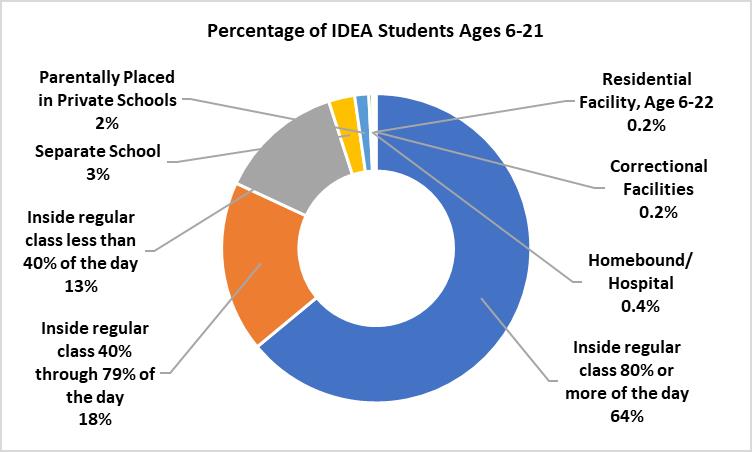IDEA Special Educational Needs Categories 2021 (Updated)
7th July 2021

Individuals with Disabilities Education Act (IDEA) was amended in 1997 and earlier it was known as The Education for All Handicapped Children Act (EHA). The changes made in IDEA deliver children as well as adolescents with different kinds of special needs access to a higher quality of education-related facilities. The law is also safeguarding all special needs apprentices get complete access to the most suitable education within the least obstructive environment in teaching special education.
The Individuals with Disabilities Education Act necessitates public schools to deliver special education amenities to entitled students. Moreover, not every learner who struggles in school qualifies for these services. A kid’s school performance needs to be “poorly affected” by a special need in one of the categories covered by the act.
Understanding the Special Education
Special education curricula are planned for those learners who are cerebrally, physically, communally and/or expressively deferred. Due to these special necessities, apprentices’ specific requirements cannot be met within a traditional classroom situation. Therefore, special education services familiarize content, different kinds of upgraded teaching methodologies and delivery instructions to meet the proper needs of each kid.
Special Educational Needs Categories Under IDEA
The descriptions of the precise special need categories are below. These are federal terms and definitions.
Autism Spectrum Disorder (ASD)
Autism Spectrum Disorder denotes a developing special need that affects the communication (both verbal and nonverbal) process along with the social interaction of a child. These indicators are characteristically apparent before the age of three and badly distress a kid’s instructive performance. Some additional recognizing features of those with ASD are engagement in repetitive activities and movements, confrontation to variation in environment and unusual responses to corporeal stimuli. A kid who displays the signs of ASD after age 3 could be identified as having ASD if the measures above are fulfilled.
Specific Learning Disability (SLD)
SLD is a huge umbrella that covers a detailed group of learning difficulties. These situations affect a kid’s aptitude to read, write, listen, speak, reason, or do the math. Here’s what usually fall in this group:
- Dyslexia
- Dysgraphia
- Dyscalculia
- Auditory processing disorder
- Nonverbal learning disability
SLD is the most common grouping under IDEA. SLD does not comprise learning glitches that are mostly the result of a visual, hearing, or motor infirmities, mental hindrance, and emotional trouble or of environmental, cultural, or economic difficulty.
Deaf-Blindness
Deaf-blindness refers to connected visual along with hearing damages. This combination causes severe communication, growing and informative requirements that cannot be billeted through special education programs only. More supports are needed for those children with blindness or deafness.
Deafness/Hearing Impairment
Deafness means a kid’s hearing damage is so severe that it affects the processing of linguistic information with or without intensification. This badly affects a child’s educational performance in the end. Hearing loss denotes an impairment that poorly affects a child’s educational performance.
Developmental Delay
It is a term selected for kids’ birth to age nine and is defined as an interruption in one or more of the following areas: cognitive development, physical development, socio-emotional development, behavioral development or communication.
Intellectual Disability
Intellectual disability is defined as a suggestively below average functioning of complete aptitude that occurs together with discrepancies in adaptive behaviour. This is demonstrated throughout the child’s evolving period causing adverse effects on the child’s educational performance. It was formerly known as Mental Retardation.

(Reference: https://bit.ly/35TkrqZ)
Emotional Disturbance
It refers to an ailment that displays one or more of the following characteristics both over a protracted period of time:
- Failure to learn that cannot be described by intellectual, sensory or health factors
- An incapability to shape and/or preserves reasonable social relationships with peers and educators
- Inaptcategories of behaviour or feelings under ordinary circumstance
- A general pervasive mood of sadness/depression
- An inclination to grow physical signs or fears allied with personal or school difficulties
Emotional disturbance does not apply to kids who are communally disturbed except they are determined to have an emotional disturbance as per IDEA’s guidelines.
Multiple Disabilities
Kids with multiple disabilities are those with connected special needs like intellectual special needs and blindness or intellectual special needs and orthopaedic impairment(s). This grouping grounds severe educational needs that cannot be met through programs designed for children with a single special need.
Orthopaedic Impairment
Orthopaedic impairment(s) signifies severe orthopaedic special needs that harmfully affect a child’s academic performance. Orthopaedic impairment(s) include those caused by congenital irregularities and ailments, as well special needs by other causes (i.e. Cerebral Palsy).
Speech or Language Impairment
This category covers complications with speech or language. A common example is stammering. Other examples are problems in articulating words or making sounds with the voice. It also covers language glitches that make it tough for children to comprehend words or express themselves.
Other Health Impairment
OHI encompasses a range of conditions. OHI’s official definition according to IDEA: “having limited strength, vitality, or alertness, including a heightened alertness to environmental stimuli, that results in limited alertness with respect to the educational environment, that— (a) is due to chronic or acute health problems such as asthma, attention deficit disorder or attention deficit hyperactivity disorder, diabetes, epilepsy, a heart condition, hemophilia, lead poisoning, leukemia, nephritis [a kidney disorder], rheumatic fever, sickle cell anemia, and Tourette syndrome; and (b) adversely affects a child’s educational performance.”
Traumatic Brain Injury
A learner with a brain injury may be suitable for special education services under the disability category traumatic brain injury (TBI).IDEA summarises the conditions that fall within this classification“an acquired injury to the brain caused by an external physical force, resulting in total or partial functional disability or psychosocial impairment, or both, that adversely affects a child’s educational performance.”
Visual Impairment
IDEA officially defines the category as “an impairment in vision that, even with correction, adversely affects a child’s educational performance. The term includes both partial sight and blindness.” It is a visual special need that includes an issue with a vision that affects a student’s academic pursuits.
Under IDEA’s legislature, all states receiving federal funding must:
- Develop an Individualized Education Program (IEP) for each child
- Recognize, locate and assess children labelled with special needs
- Teach children with special needs within their "least obstructive environment"
- Deliverlearners with special needs enrolled in early-intervention (EI) programs
- Make available special education facilities for those children joined in private schools
- Confirm teachers are sufficiently competent and certified to teach special education
Conclusion
Becoming a certified special education instructor allows you to work with an extensive range of student ages, grade levels, and aptitudes. SEN courses for teachers are planned to meet the precise and exclusive instructional needs of each kid. You may work in specialized/self-contained schools, general education classrooms, various early intervention programs, hospitals, home programs, residential families, inclusion model preschool programs and so on.
Written By : Katharina

